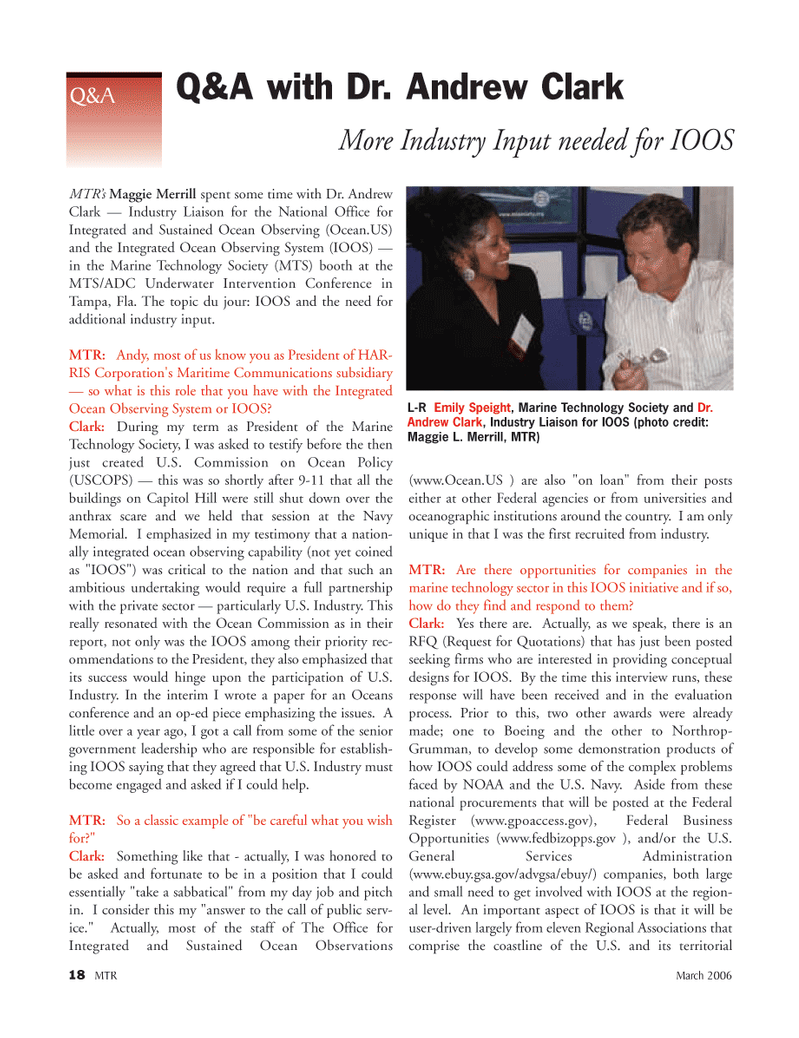
Page 17: of Marine Technology Magazine (March 2006)
AUVs; ROVs; UUVs
Read this page in Pdf, Flash or Html5 edition of March 2006 Marine Technology Magazine
MTR’s Maggie Merrill spent some time with Dr. Andrew
Clark — Industry Liaison for the National Office for
Integrated and Sustained Ocean Observing (Ocean.US) and the Integrated Ocean Observing System (IOOS) — in the Marine Technology Society (MTS) booth at the
MTS/ADC Underwater Intervention Conference in
Tampa, Fla. The topic du jour: IOOS and the need for additional industry input.
MTR: Andy, most of us know you as President of HAR-
RIS Corporation's Maritime Communications subsidiary — so what is this role that you have with the Integrated
Ocean Observing System or IOOS?
Clark: During my term as President of the Marine
Technology Society, I was asked to testify before the then just created U.S. Commission on Ocean Policy (USCOPS) — this was so shortly after 9-11 that all the buildings on Capitol Hill were still shut down over the anthrax scare and we held that session at the Navy
Memorial. I emphasized in my testimony that a nation- ally integrated ocean observing capability (not yet coined as "IOOS") was critical to the nation and that such an ambitious undertaking would require a full partnership with the private sector — particularly U.S. Industry. This really resonated with the Ocean Commission as in their report, not only was the IOOS among their priority rec- ommendations to the President, they also emphasized that its success would hinge upon the participation of U.S.
Industry. In the interim I wrote a paper for an Oceans conference and an op-ed piece emphasizing the issues. A little over a year ago, I got a call from some of the senior government leadership who are responsible for establish- ing IOOS saying that they agreed that U.S. Industry must become engaged and asked if I could help.
MTR: So a classic example of "be careful what you wish for?"
Clark: Something like that - actually, I was honored to be asked and fortunate to be in a position that I could essentially "take a sabbatical" from my day job and pitch in. I consider this my "answer to the call of public serv- ice." Actually, most of the staff of The Office for
Integrated and Sustained Ocean Observations (www.Ocean.US ) are also "on loan" from their posts either at other Federal agencies or from universities and oceanographic institutions around the country. I am only unique in that I was the first recruited from industry.
MTR: Are there opportunities for companies in the marine technology sector in this IOOS initiative and if so, how do they find and respond to them?
Clark: Yes there are. Actually, as we speak, there is an
RFQ (Request for Quotations) that has just been posted seeking firms who are interested in providing conceptual designs for IOOS. By the time this interview runs, these response will have been received and in the evaluation process. Prior to this, two other awards were already made; one to Boeing and the other to Northrop-
Grumman, to develop some demonstration products of how IOOS could address some of the complex problems faced by NOAA and the U.S. Navy. Aside from these national procurements that will be posted at the Federal
Register (www.gpoaccess.gov), Federal Business
Opportunities (www.fedbizopps.gov ), and/or the U.S.
General Services Administration (www.ebuy.gsa.gov/advgsa/ebuy/) companies, both large and small need to get involved with IOOS at the region- al level. An important aspect of IOOS is that it will be user-driven largely from eleven Regional Associations that comprise the coastline of the U.S. and its territorial 18 MTR March 2006
Q&A
Q&A with Dr. Andrew Clark
More Industry Input needed for IOOS
L-R Emily Speight, Marine Technology Society and Dr.
Andrew Clark, Industry Liaison for IOOS (photo credit:
Maggie L. Merrill, MTR)
MTR#2 (17-32).qxd 2/23/2006 4:59 PM Page 18

 16
16

 18
18
